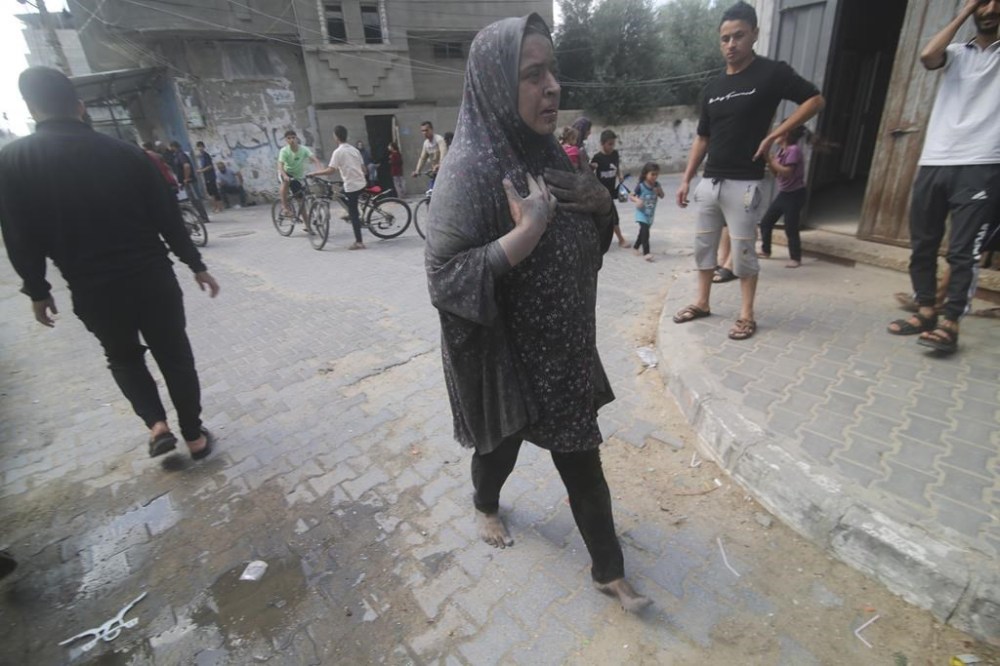No place is safe in Gaza after Israel targets areas where civilians seek refuge, Palestinians say
Advertisement
Read this article for free:
or
Already have an account? Log in here »
To continue reading, please subscribe:
Monthly Digital Subscription
$0 for the first 4 weeks*
- Enjoy unlimited reading on winnipegfreepress.com
- Read the E-Edition, our digital replica newspaper
- Access News Break, our award-winning app
- Play interactive puzzles
*No charge for 4 weeks then price increases to the regular rate of $19.00 plus GST every four weeks. Offer available to new and qualified returning subscribers only. Cancel any time.
Monthly Digital Subscription
$4.75/week*
- Enjoy unlimited reading on winnipegfreepress.com
- Read the E-Edition, our digital replica newspaper
- Access News Break, our award-winning app
- Play interactive puzzles
*Billed as $19 plus GST every four weeks. Cancel any time.
To continue reading, please subscribe:
Add Free Press access to your Brandon Sun subscription for only an additional
$1 for the first 4 weeks*
*Your next subscription payment will increase by $1.00 and you will be charged $16.99 plus GST for four weeks. After four weeks, your payment will increase to $23.99 plus GST every four weeks.
Read unlimited articles for free today:
or
Already have an account? Log in here »
Hey there, time traveller!
This article was published 17/10/2023 (771 days ago), so information in it may no longer be current.
DEIR al-BALAH, Gaza Strip (AP) — Even the “safe zones” of Gaza aren’t safe for Palestinians.
Intense Israeli strikes Tuesday destroyed homes, hit a U.N. school sheltering the displaced and killed dozens of people in south and central Gaza.
“The situation is very, very difficult with artillery shelling and aerial bombardment on homes and defenseless people,” said Abu Hashem Abu al-Hussein, who initially welcomed displaced families into his home in Khan Younis, but then fled to a U.N. school, where he hoped to find safety himself.

Israel had told Palestinians over the weekend to evacuate northern Gaza and Gaza City in advance of an expected ground invasion of the territory following an attack by Hamas militants last week that killed at least 1,400 Israelis.
An estimated 600,000 people complied, packing what belongings they could and rushing to the south, where they squeezed into overcrowded U.N. shelters, hospitals, and homes in the approximately 14-kilometer (8-mile) long area south of the evacuation zone.
Israeli Prime Minister Benjamin Netanyahu accused Hamas on Tuesday of preventing people from “getting out of harm’s way,” and he again urged Palestinians to head “south to safe zones”
For some on Tuesday, there was no safety to be had there.
After midnight Tuesday morning, an explosion shattered Moataz al-Zre’e’s windows. He rushed outside to find his neighbor Ibrahim’s entire home had been razed. The house next door was damaged also. At least 12 people from two families were killed, including three people from a family displaced from Gaza City.
“There was no (Israeli) warning,” he said. Al-Zre’e’s sister was gravely wounded and five of his paternal cousins were also injured following the attack. “Most of the killed were women and children.”
Stunned residents took stock of the damage from another strike in Khan Younis. Samiha Zoarab looked around at the destruction in shock, as children rummaged through piles of rubble around the destroyed home, which lies amid a dense cluster of buildings.
At least four people from the same family were killed in the attack, she said. “There are only two survivors,” she said.
A strike hit a U.N. school in central Gaza where 4,000 Palestinians had taken refuge, killing six people, the U.N. agency for Palestinian refugees said.
A barrage leveled a block of homes in the central Gaza Bureij refugee camp, killing many inside, residents said. Among the killed was Ayman Nofal, a top Hamas military commander.
Strikes also hit the cities of Rafah, where 27 were reported killed, and Khan Younis, where 30 were reported killed, according to Bassem Naim, a senior Hamas official.
The Israeli military said it was targeting Hamas hideouts, infrastructure and command centers.
The strikes came even as residents struggled with an Israeli blockade that cut off the flow of water, food, fuel and medicine to the area.
The Kuwait Speciality Hospital in the southern city of Rafah has received two orders from the Israeli military to evacuate said staff had just two hours to leave after Sunday’s order, in a video posted to the hospital’s Facebook group. The second came Monday at 10 p.m., as medics worked around the clock to resuscitate patients. “We shall not evacuate,” he said.
The Israeli army did not immediately comment on why it had called for the hospital evacuation.
Apart from the near-constant stream of wounded patients, the hospital was also sheltering hundreds of people inside its halls and surroundings. Israel “has left no red line they did not cross, nor an international convention they did not violate,” said al-Hams. The safety of hospitals, he added, was the last red line left.




